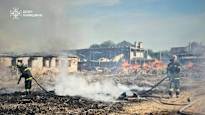In the realm of modern warfare, the evolution of technology has paved the way for new tactics and strategies. Recently, the world witnessed a significant escalation as Russia conducted its most extensive aerial assault on Ukraine, utilizing a combination of drones and missiles. This surge in drone attacks, expertly executed by Russia, has raised concerns and shed light on the changing dynamics of warfare in the region.
Spearheading the analysis of these events is Pasi Paroinen, a seasoned war expert from the Black Bird Group. Paroinen’s insights reveal a troubling trend as Russia intensifies its drone and missile strikes, aiming to weaken Ukraine’s defense capabilities. By employing sophisticated drones, including decoy drones that pose challenges for Ukrainian radar systems, Russia has managed to launch relentless attacks, stretching Ukraine’s resources thin and forcing difficult strategic decisions.
“Russia’s ability to conduct extensive drone attacks is bolstered by a combination of factors, including Ukraine’s equipment shortages, Russia’s domestic drone production, leakage of sanctions, and crucially, support from China,”
notes Paroinen. The intricate interplay of these elements not only underscores the complexity of the conflict but also highlights the multifaceted nature of modern warfare.
The repercussions of these developments extend beyond the immediate battlefield, delving into the realm of international relations and geopolitical dynamics. The recent decision by the United States to suspend certain arms shipments to Ukraine, followed by a subsequent pledge to provide Patriot missiles, underscores the intricate web of alliances and power plays at play.
While the influx of Patriot missiles may offer some reprieve to Ukraine, experts like Paroinen caution that it may not be adequate to significantly enhance Ukraine’s defense capabilities. The global arms race and the shifting allegiances in the region further complicate the situation, with China emerging as a key player in enabling Russia’s military endeavors.
“China’s support for Russia in the ongoing conflict signals a potential shift in their relationship dynamics, with China potentially becoming a more overt supporter of Russia in the future,”
suggests Paroinen. The specter of a more open alignment between China and Russia raises concerns about the broader implications for international security and stability.
As the world watches the unfolding events in Eastern Europe, the role of technology, alliances, and diplomatic maneuvers in shaping the outcome of the conflict becomes increasingly apparent. The intricate dance of power and influence on the global stage underscores the need for nuanced analysis and strategic foresight in navigating the complexities of modern warfare.
In the midst of escalating tensions and evolving alliances, the future of the conflict hangs in the balance, with each move and decision shaping the course of history. As experts and policymakers grapple with the intricacies of the situation, one thing remains clear – the stakes are high, and the consequences are far-reaching.
The conflict in Ukraine serves as a stark reminder of the volatile nature of geopolitics and the fragility of peace in the modern world. As nations maneuver and strategize in the pursuit of their interests, the human cost of war looms large, underscoring the imperative of dialogue, diplomacy, and cooperation in averting further escalation and fostering lasting peace.

